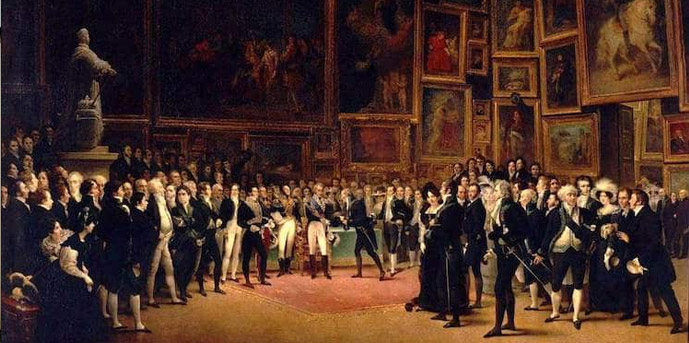Temporary art displays have existed for a very long time in history. The popular displays have changed from salons to blockbuster events to themed group shows. These daring new curatorial forms changed the manner in which individuals viewed art. Therefore, it undoubtedly controlled the course of imaginative development.
Let’s take a look at some of the famous art exhibitions that made history:
1. Paris Salon, 1824
In 19th century Paris, the public saw new masterpieces Salon presentations yearly. Therefore, Jury individuals chose artworks by their companions for presentation. And the picked works before long became powerful benchmarks of creative patterns. It was the canvases of verifiable occasions are considered the most renowned.
In the Salon of 1824, there were emotional scenes by John Constable. As well as expressive history canvases by Eugéne Delacroix! These works underscored the supremacy of nature over adherence to old-style scholastic practice. The momentary second is known as the “Heartfelt Salon”.
2. Salon de Refusés, 1863
The Salon des Refusés was started in light of the grievances of specialists. Their works had not been acknowledged for presentation. Contemporary records announced rooms brimming with onlookers scandalized by the exciting female nakedness. This was shown in Édouard Manet’s Déjeuner sur l’herbe. And astounded by James McNeill Whistler’s Symphony in White, No. 1: The White Girl. The works have stayed popular and admired by many.
3. Rembrandt Exhibition, 1898
Rembrandt was dynamic in the 16th century and had been assigned the “Ruler of Dutch Painting” in the 19th century. The display was coordinated to praise Princess Wilhelmina’s initiation as Queen of the Netherlands. Therefore, this display is frequently viewed as the primary blockbuster exhibition hall show. And the organisation of the show required huge exertion since many works by Rembrandt stayed in the Netherlands.
The organizing committee acquired more than 100 works from illustrious houses and establishments across Europe. This was one of the primary single-craftsman displays. And an early illustration of a state sending a workmanship show to project social force!
4. Manet and the Post-Impressionists, 1910
The guardian Roger Fry masterminded this milestone display. Which included works by Paul Gaugin, Édouard Manet, Henri Matisse and Vincent van Gogh. Fry authored the expression ‘post-impressionism’. This despite a scope of new arts rehearses and built up connections to the notable Impressionist development.
While the general population disparaged the chips away at a show. Fry’s term ‘post-impressionism’ served to contextualize new imaginative practices and arrange them into a rational arts authentic story.
5. International Exhibition of Modern Art, 1913
For crowds in New York, the main arsenal show filled in as a prologue to Cubism and theoretical workmanship. The two of which were gotten with distrust. The presentation allowed American crowds an opportunity to see Marcel Duchamp’s Nude Descending the Staircase. And undoubtedly this evoked shock.
An achievement for present-day arts in America, the enormous display is broadly viewed as an impetus for the American workmanship market.
6. Bauhaus Exhibition, 1923
The German Bauhaus had been framed in 1919. After four years, the school displayed plans by Le Corbusier and Ludwig Mies van der Rohe. It distributed Walter Gropius’ article Art and Technology – A New Unity. The assertion was a flight for the school. Which had progressed a more expressionist style up to that point.
In the midst of a political disturbance in 1924, the Bauhaus was moved to Dessau, Germany. The constructive structures and building methods advanced in 1923. And the displays have stayed persuasive in current workmanship.

